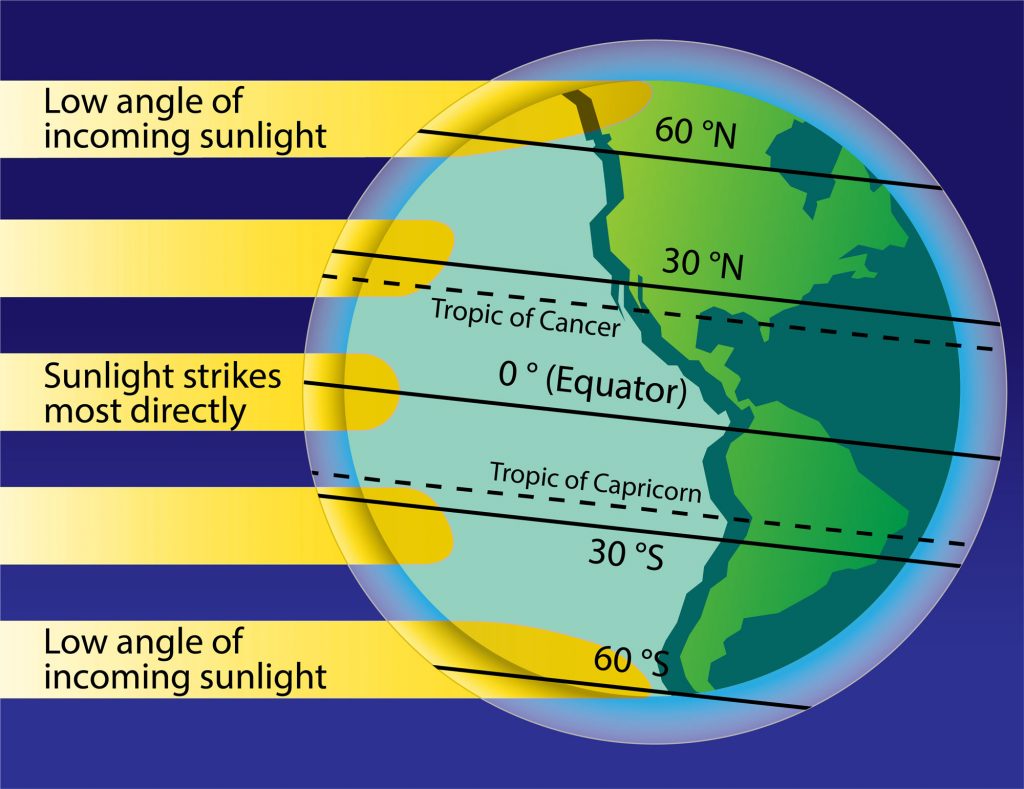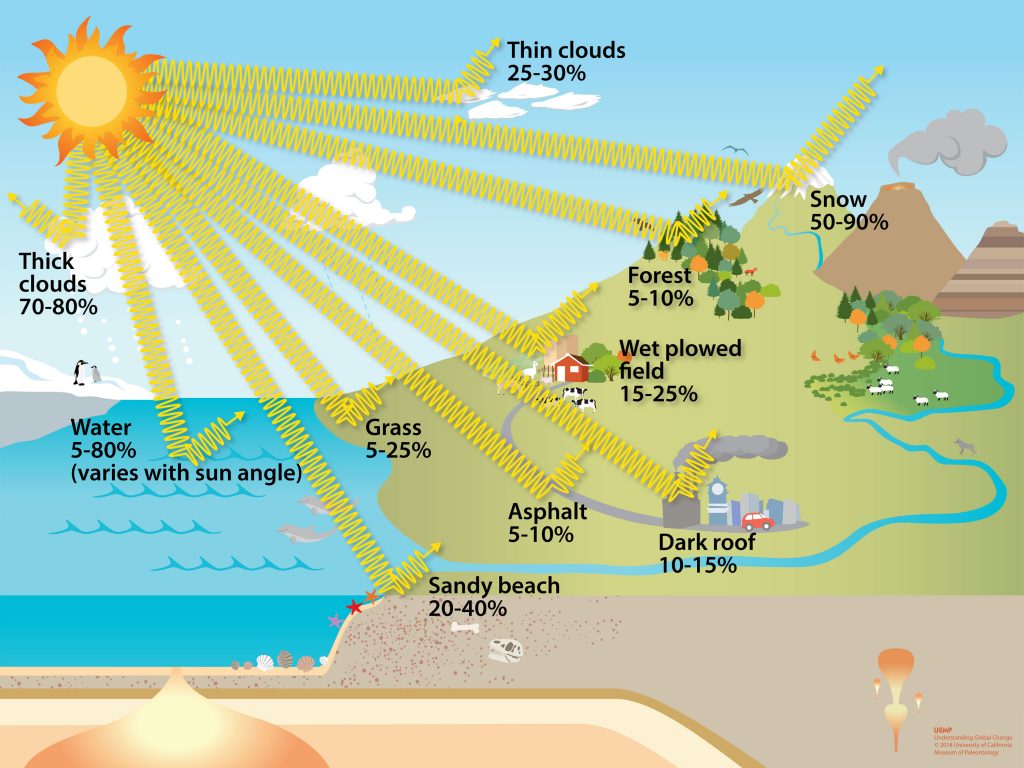At what angle to the earths surface does the Suns rays heat up the earth the most?
What is the absorption and reflection of sunlight?
The Lord's day provides the Earth with almost of its free energy. Today, about 71% of the sunlight that reaches the Earth is absorbed by its surface and atmosphere. Absorption of sunlight causes the molecules of the object or surface it strikes to vibrate faster, increasing its temperature. This free energy is and then re-radiated past the Earth every bit longwave, infrared radiation, also known as heat. The more than sunlight a surface absorbs, the warmer it gets, and the more energy it re-radiates as heat. This re-radiated rut is then absorbed and re-radiated by greenhouse gases and clouds, and warm the temper through the greenhouse issue.
Globe'due south surfaces are better at absorbing solar radiation than air, particularly surfaces that are dark in color. You can feel this on a cold wintertime day when the sunshine warms your face and the air effectually you remains cold. Your skin and your clothes also blot solar radiation and convert information technology to heat. If you wear a black jacket, information technology will absorb more than radiation and make yous feel warmer than if you lot wear a white or low-cal-colored jacket. Similarly, World's unlike surfaces and parts of the atmosphere absorb solar radiations at dissimilar rates.

The Globe is unevenly heated because it is a sphere.
Because Earth is a sphere, not all part of the Earth receives the aforementioned amount of solar radiation. More solar radiation is received and absorbed nigh the equator than at the poles. Near the equator, the Dominicus's rays strike the Earth virtually directly, while at the poles the rays strike at a steep bending. This ways that less solar radiations is absorbed per square cm (or inch) of surface area at higher latitudes than at lower latitudes, and that the tropics are warmer than the poles. This temperature difference shapes global atmospheric and ocean circulation patterns. Additionally, World'due south tilt affects how much sunlight is received and absorbed by dissimilar parts of the Earth at various times of the year, and is why we experience the seasons. The amount of solar radiation received and absorbed also influences process in the biosphere by directly affecting plants and other organisms that photosynthesize and are the primary nutrient source in most ecosystems (encounter species interactions).
If lite is not absorbed by a surface, it is mostly reflected. Reflection occurs when incoming solar radiation bounces back from an object or surface that information technology strikes in the atmosphere, on land, or h2o, and is not transformed into heat. The proportion of incoming solar radiations that is reflected by the Earth is known as its albedo. Overall, Earth reflects most 29% of the incoming solar radiations, and therefore, nosotros say the World's average albedo is 0.29.
Snow and water ice, airborne particles, and certain gases have high albedos and reflect different amounts of sunlight back into infinite. Low, thick clouds are reflective and tin block sunlight from reaching the Earth's surface, while loftier, thin clouds can contribute to the greenhouse event.
The proportion of sunlight that'southward reflected vs. absorbed, the re-radiation of heat, and the intensity of the greenhouse effect influence the amount of energy in the Globe system and global processes such as the h2o bike and atmospheric and sea circulation.

This diagram shows the percentage of sunlight that is reflected by different Earth surfaces or clouds.
Earth organisation models virtually the absorption and reflection of sunlight
This World system model is one way to represent the essential processes and interactions related to the absorption and reflection of sunlight. Hover over the icons for brief explanations; click on the icons to learn more almost each topic. Download the Globe system models on this page.
This model shows some of the changes to Earth's surface and atmosphere that can bear upon the amount of sunlight that is captivated or reflected. These changes influence the corporeality of estrus that is re-radiated, and can also greatly influence the biosphere past altering the amount of sunlight available for photosynthesis.
How human being activities influence the absorption and reflection of sunlight
The Earth system model beneath includes some of the means that human activities directly affect the corporeality of sunlight that is absorbed and reflected by Earth's surface. The development and spread of urban areas, especially using asphalt and other night colored materials, can dramatically increment the absorptivity of the surface. This creates urban rut islands, where cities experience college temperatures than surrounding areas. Hover over or click on the icons to larn more about these human causes of change and how they influence the absorption and reflection of sunlight.
The Earth system model below includes boosted ways that man activities straight impact the amount of sunlight that is absorbed and reflected by World's atmosphere. Hover over or click on the icons to acquire more almost these human causes of change and how they influence the absorption and reflection of sunlight.
The Earth arrangement model below shows how human pollutants and waste bear on the ozone layer and the corporeality of ultraviolet sunlight that is absorbed by Earth'southward upper atmosphere (the stratosphere). Hover over or click on the icons to learn more about these human causes of modify and how they influence the absorption and reflection of sunlight.
Explore the Earth System
Click the icons and bolded terms (east.m. re-radiation of heat, airborne particles, etc.) on this page to learn more than about these process and phenomena. Alternatively, explore the Understanding Global Change Infographic and detect new topics that are of involvement and/or locally relevant to you.
To learn more near teaching the absorption and reflection of sunlight, visit the Education Resources page.
Links to Learn More than
- Earth's Energy Upkeep
- Measuring Earth's Albedo via Satellite/ CERES
- A brief description of NASA'due south "Clouds and the Earth's Radiant Energy System" (CERES) satellite instruments
- Wood Pigsty Oceanographic Institution: How tiny plants help make clouds
- Globe's Albedo and Global Warming
- NOAA Science on a Sphere, Aerosols: Blackness carbon and sulfate
- Ozone: What is it, and why practice nosotros care about information technology?
Source: https://ugc.berkeley.edu/background-content/reflection-absorption-sunlight/
0 Response to "At what angle to the earths surface does the Suns rays heat up the earth the most?"
Postar um comentário